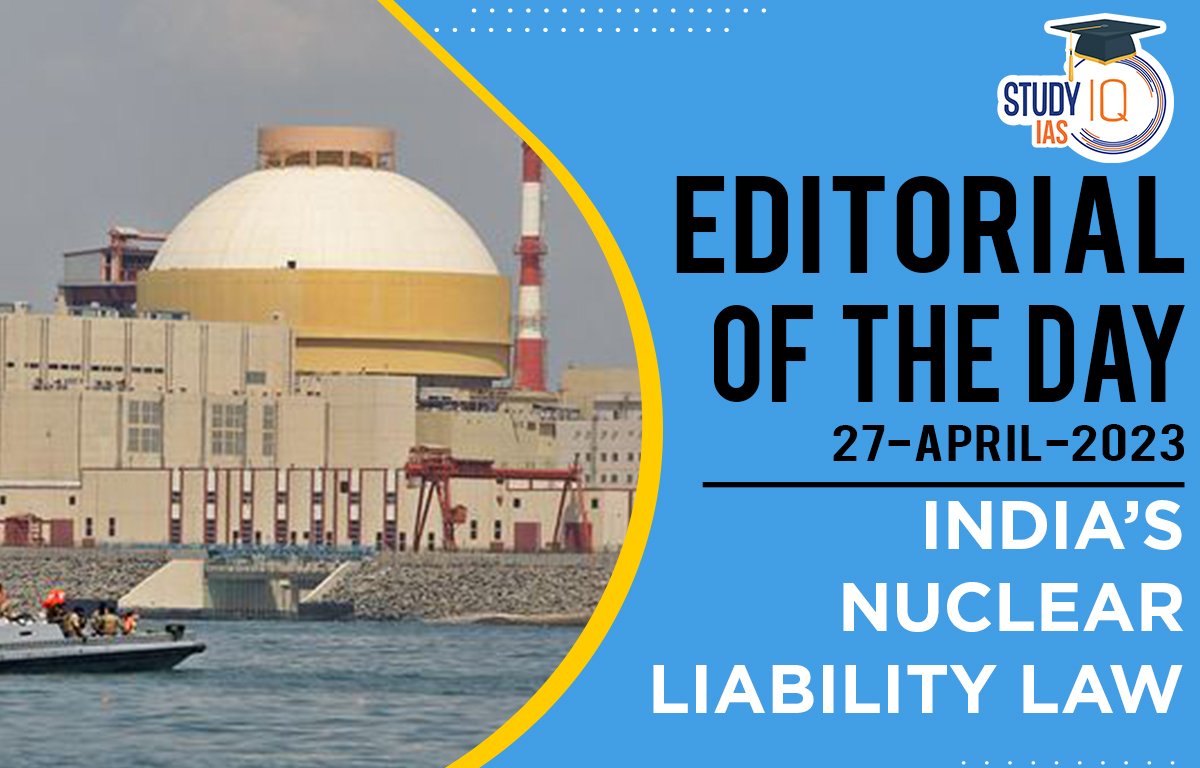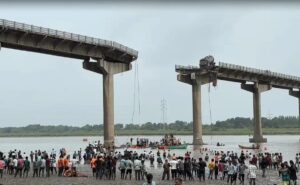Table of Contents
Context: The article is discussing the issues surrounding India’s nuclear liability law, which is currently preventing the construction of six nuclear power reactors in Maharashtra’s Jaitapur, which is considered to be the world’s biggest nuclear power generation site under consideration. It also highlights the provisions of the Indian nuclear liability law, what it says about supplier liability in the event of a nuclear accident, why some provisions in the law continue to make foreign companies wary of signing deals with India and the government’s view on the issue. The issue has caught the limelight in the backdrop of the French energy company Electricite de France (EDF) submitting a techno-commercial offer for the construction of the 9,900 MW project, but have raised concerns about the issues arising from India’s nuclear liability law that needs to be resolved before any contract could be signed.
BIndia’s Nuclear Liability Law Background
What is Civil Liability for Nuclear Damage?
- It refers to the legal responsibility of operators of nuclear facilities to compensate individuals or communities for any harm or loss caused by a nuclear accident.
- This includes compensation for bodily injury, loss of life, property damage, economic loss, and damage to the environment.
- The objective of civil liability for nuclear damage is to ensure that victims of a nuclear accident are compensated fairly and quickly, and that the financial burden is borne by those who operate and profit from nuclear facilities.
- It is also intended to encourage operators to take measures to prevent accidents and to improve safety at nuclear facilities.
Global Conventions related to Civil Liability for Nuclear Damage
| Vienna Convention on Civil Liability for Nuclear Damage | It is a global treaty that establishes a framework for the civil liability and compensation of victims of a nuclear accident.
The convention was adopted in 1963 and entered into force in 1977. It has been ratified by 67 countries, including most of the nuclear-armed states. (India is not a party) The convention aims at harmonizing the national law of the Contracting Parties by establishing some minimum standards to provide financial protection against damage resulting from certain peaceful uses of nuclear energy. 1997 Protocol to Amend the Vienna Convention: The Protocol aims at amending the Vienna Convention in order to provide for broader scope, increased liability of the operator of a nuclear installation and enhanced means for securing adequate and equitable compensation. |
| Paris Convention on Third Party Liability in the Field of Nuclear Energy | This convention was adopted in 1960 and sets out the principles of liability for nuclear damage and establishes a system of compulsory insurance for nuclear operators in participating states. |
| Joint Protocol Relating to the Application of the Vienna Convention and the Paris Convention: | This protocol was adopted in 1988 and provides a framework for the application of both the Vienna and Paris conventions to a nuclear incident that occurs in a participating state. |
| Convention on Supplementary Compensation (CSC) for Nuclear Damage | The convention was adopted in 1997 and entered into force in 2015.
It aims at establishing a minimum national compensation amount to compensate the damage caused by a nuclear incident. The Convention is open not only to States that are party to either the Vienna Convention or the Paris Convention, but also to other States provided that their national legislation is consistent with uniform rules on civil liability laid down in the Annex to the Convention. Currently, the convention has 11 Contracting Parties and 11 Signatories. India is a signatory to the convention. |

Disasters and Relevant Remedy:
- Chernobyl disaster (1986): The Chernobyl nuclear power plant disaster in Ukraine was caused by a combination of design flaws and operator errors, resulting in a massive release of radioactive material. In 1991, the Soviet Union agreed to compensate the victims and the affected regions under the Vienna Convention on Civil Liability for Nuclear Damage.
- Fukushima disaster (2011): The Fukushima nuclear disaster in Japan was caused by a massive earthquake and tsunami that led to multiple reactor meltdowns and releases of radioactive material. Japan has its own civil liability law, the Act on Compensation for Nuclear Damage, which provides for compensation to victims of nuclear accidents.
- Jaduguda Mine Radiation Leak (2008): A radiation leak occurred at the Jaduguda uranium mine in Jharkhand, India in 2008, which contaminated the nearby groundwater. There were reports of radiation-related health problems among workers and nearby residents. Compensation was paid under the Indian nuclear liability law, the Civil Liability for Nuclear Damage Act, 2010.
- Kalpakkam Atomic Reprocessing Plant Accident (2003): There was an accident at the Kalpakkam atomic reprocessing plant in Tamil Nadu in 2003, which resulted in a release of radioactive material. No injuries or fatalities were reported, but there were concerns about the potential impact on the environment and public health.
Decoding the Editorial
The article provides an overview of the international nuclear liability regime and the purpose of laws on civil nuclear liability. It explains that such laws ensure that compensation is available to the victims for any nuclear damage caused by an incident or disaster and set out who will be responsible for paying such compensation. It also discusses about:
- Convention on Supplementary Compensation (CSC):
- This convention was adopted in 1997 to establish a minimum national compensation amount and allows for further public funds to be made available if the national amount is insufficient to compensate for the damage caused by a nuclear incident.
- Although India was a signatory to the Convention, it only ratified the convention in 2016.
- Civil Liability for Nuclear Damage Act (CLNDA):
- To comply with the Convention on Supplementary Compensation (CSC), India enacted the Civil Liability for Nuclear Damage Act (CLNDA) in 2010, which provides for a compensation mechanism for victims of a nuclear accident.
- The CLNDA establishes strict and no-fault liability on the operator of the nuclear plant and sets a limit of ₹1,500 crore for the amount the operator must pay in case of damage caused by an accident.
- The operator is required to cover liability through insurance or other financial security, and if damage claims exceed ₹1,500 crore, the government is expected to step in, with its liability limited to about ₹2,100 to ₹2,300 crore.
- The Act also specifies the limitations on the amount and time when action for compensation can be brought against the operator.
- CSC Vs CLNDA’s say on supplier liability:
- CSC: The international legal framework on civil nuclear liability, is based on the principle of exclusive liability of the operator of a nuclear installation and no other person (exclusive operator liability, and circumstantial supplier liability)
- This means that only the operator of the nuclear plant is held liable for any nuclear damage that occurs, and not any other parties such as suppliers of nuclear equipment.
- Section 10 of the annex of the Convention on Supplementary Compensation (CSC) stipulates only two circumstances where the national law of a country may allow the operator of a nuclear plant to seek recourse from the supplier for compensation:
- If the supplier agrees to it in the contract, and
- If the nuclear incident was a result of an intentional act or omission by the supplier to cause damage.
- The rationale for this principle includes avoiding legal complications in establishing separate liability for each case and making it easier for the operator to take out insurance, rather than having multiple entities in the chain taking out their own insurance.
- This principle was accepted in the early stages of the nuclear industry’s development, with foreign governments and the industry agreeing that excessive liability claims against suppliers of nuclear equipment would hinder the growth of nuclear energy.
- CLNDA: India’s Civil Liability for Nuclear Damage Act (CLNDA) goes beyond the two conditions laid out in the international legal framework on civil nuclear liability for supplier liability.
- It introduced the concept of supplier liability over and above that of the operator’s liability.
- The architects of the law recognized that defective parts played a role in historical incidents such as the Bhopal gas tragedy and added a clause on supplier liability.
- In addition to the contractual right of recourse or when “intent to cause damage” is established, Section 17(b) of the CLNDA states that the operator of the nuclear plant has the right to recourse where the nuclear incident results from an act of the supplier or their employee, including the supply of equipment or material with defects or sub-standard services.
- CSC: The international legal framework on civil nuclear liability, is based on the principle of exclusive liability of the operator of a nuclear installation and no other person (exclusive operator liability, and circumstantial supplier liability)
- Issue with supplier liability clause in Nuclear Deals: The civil nuclear liability law in India, the CLNDA, includes two provisions that have caused concerns for suppliers of nuclear equipment:
- Section 17(b): This section introduces supplier liability, allowing the operator of a nuclear plant to seek recourse from the supplier goes beyond the exclusive liability of the operator principle that is central to the international legal framework on civil nuclear liability.
- Section 46: This allows civil liability claims to be brought against both the operator and the supplier through other civil laws such as the law of tort, in the absence of a comprehensive definition of the types of ‘nuclear damage’ being notified by the Central Government.
- This exposes suppliers to potentially unlimited liability, while liability for operators is capped by the CLNDA.
- These provisions have been sticking points for suppliers and have made them hesitant to operationalize nuclear deals with India.
Government’s Stand on the Issue:
- Regarding Section 17(b) of the law, the government says that this provision only allows, but does not mandate, the operator to include the right of recourse in the contract or exercise such a right.
- This implies that the operator has the option to seek recourse from the supplier if it can establish that the supplier’s actions or omissions caused a nuclear incident, but it is not obligated to do so.
- However, legal experts argue that the three subsections of the provision – 17(a), (b), and (c) – are separate and distinct from one another.
- Even if a contract does not include the right to recourse against the supplier, as provided by Section 17(a), the other two subsections remain in effect.
- This means that a supplier could still be held liable if they provided defective equipment or if it can be proven that the damage resulted from an intentional act.
- Moreover, it would not be prudent public policy for the NPCIL, a government entity, to enter into a contract with a supplier and waive its right to recourse, as provided for by law.
- The Ministry of External Affairs has stated that the CLNDA, as passed by Parliament, does not include the liability of suppliers, and therefore they cannot be held liable under a “class-action suit”.
- However, private sector players and legal experts argue that during a trial, what matters is what is stated in the law, and not what was discussed in Parliament.
Beyond the Editorial
There are a few steps that India could take to strengthen its legal framework for civil liability for nuclear damage:
- Clarify the definition of “nuclear damage”: There are several ways that India can strengthen its legal framework for civil liability for nuclear damage under the CLNDA.
-
- Firstly, the government can provide clarity on the definition of “nuclear damage” under Section 2(g) of the Act to avoid ambiguity in interpretation.
- Secondly, it can provide more specific guidelines for the determination of compensation for victims of a nuclear incident.
- Thirdly, it can consider amending Section 46 of the Act to remove the potential for civil liability claims to be brought against the operator and suppliers through other civil laws such as the law of tort.
- Fourthly, it can work towards harmonising the CLNDA with international conventions such as the CSC, to promote greater clarity and consistency in liability and compensation regimes across different countries.
- Increase the cap on operator liability: While the current cap on operator liability is Rs. 1,500 crores, this amount may not be sufficient to cover damages in the event of a major nuclear accident. Increasing the cap on operator liability could provide greater financial protection to potential victims.
- Provide greater clarity on supplier liability: Providing greater clarity on supplier liability could help to reassure potential suppliers and encourage greater investment in India’s civil nuclear sector.
- Strengthen the regulatory framework: India’s nuclear regulatory framework has been criticized for being insufficiently independent and transparent. Strengthening the regulatory framework could help to increase public trust in the safety of India’s nuclear installations.


 Chakma and Hajong Communities: History, ...
Chakma and Hajong Communities: History, ...
 Commission for Air Quality Management (C...
Commission for Air Quality Management (C...
 Gujarat Bridge Collapse: 9 Dead as Gambh...
Gujarat Bridge Collapse: 9 Dead as Gambh...





















